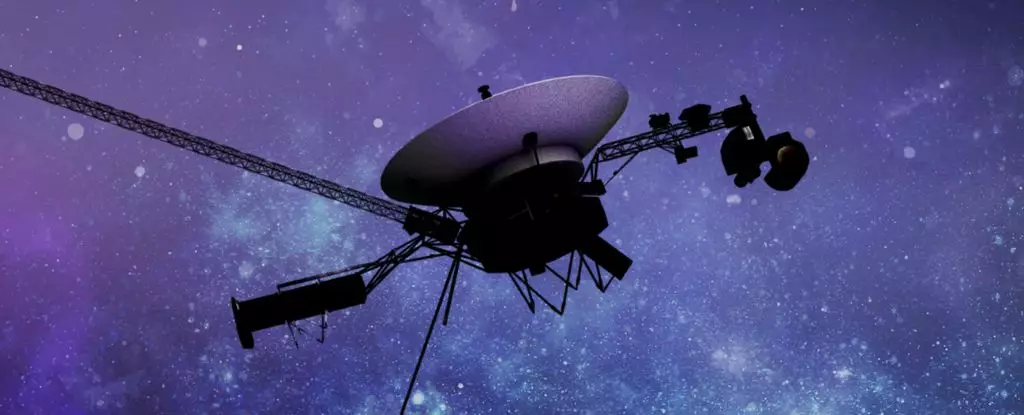NASA’s Voyager 1 spacecraft, the farthest human-made object from Earth, recently faced a communication crisis that serves as a poignant reminder of the challenges inherent in space exploration. Last month, what began as a routine operation of turning on a heater spiraled into an unexpected communication blackout. This incident not only highlighted the incredible distance that separates us from this remarkable spacecraft but also the aging technology that has been tirelessly transmitting data from the outer reaches of our solar system for nearly half a century.
Voyager 1, launched in 1977, embarked on a mission that would transcend the boundaries of our solar system, traveling approximately 25 billion kilometers (or 15.3 billion miles) away from Earth. Due to this immense distance, signals take nearly 23 hours to traverse one way, making immediate communication nearly impossible. The distance magnifies any operational hiccups, and as seen in the most recent incident, operational challenges can lead to profound consequences.
The trouble began on October 16, when technicians at NASA commanded Voyager 1 to activate a heater essential for its instruments. In a perplexing twist, the probe mysteriously stopped responding altogether, a development that eluded NASA’s attention for nearly two days. The missed call on October 18 raised alarms, prompting the team to scan for a signal. To their surprise, the spacecraft had altered its communication strategy. Instead of its usual X-band radio transmitter, which had been operational for over four decades, Voyager 1 had defaulted to the weaker S-band transmitter—a safety mechanism designed to conserve power.
This automatic switch was triggered by a built-in fault protection system that protects the probe’s functions when power levels are compromised. By redirecting its transmission, Voyager 1 demonstrated an admirable level of autonomy, yet it also introduced a new set of complications. NASA was confronted with the task of re-establishing contact with a signal that hadn’t been utilized since 1981. Although the engineers successfully regained communication by October 22, the underlying issues remained unresolved, leading to fears that further complications might ensue.
As the flight operations team continued their diagnostics, they grew increasingly cautious about reactivating the X-band transmitter without fully understanding the underlying cause of its failure. The fact that the 45-year-old spacecraft was still able to communicate—albeit through its less potent transmitter—was impressive, yet it underscored the fragility of its systems in the face of aging technology.
In fact, Voyager 1 is not alone in its struggles; both Voyager probes have faced a series of technical glitches in recent years. A memory corruption issue led to months of corrupted telemetry data in 2022, and periods of silence on the line have oscillated their capacity to relay scientific data. The frequency of these anomalies raises questions about the longevity and sustainability of these pioneering vehicles as they approach the twilight of their operational lives.
As both Voyager probes drift further into the void of interstellar space, they carry with them a wealth of knowledge and an invaluable record of human history. They provide insights into regions of space that remain largely unexplored and continue to relay information about solar winds and cosmic radiation. However, the expectation that they will cease to provide data by 2025 due to dwindling power supplies creates a pressing urgency for scientists to maximize their output in the limited remaining time.
The Voyager missions not only encapsulate the height of human ingenuity and curiosity but also represent humanity’s enduring quest to understand the universe. The time frame for continuous communication is narrowing; by 2036, both probes will drift beyond the reach of NASA’s Deep Space Network. The implications of this potential loss are profound as these crafts are expected to carry the legacy of human culture into the distant future, perhaps witnessing close encounters with stars long after humanity fades into memory.
The Voyager 1 incident serves as a reminder of the impermanence and unpredictability of space exploration. The resilience and adaptability of these spacecraft inspire awe and admiration, eliciting a sense of responsibility to safeguard the mission as long as possible. While they operate far beyond our reach, they remain a testament to human achievement and a beacon of hope for future explorations into the mysteries of the universe. Voyager 1, with all its quirks and challenges, continues its journey, steadfastly carrying the torch of human exploration into the cosmic horizon, embarking on a voyage that will far outlast the civilization that sent it forth.


Leave a Reply